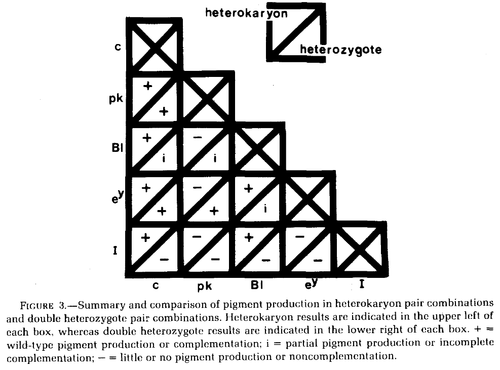Difference between revisions of "Unusual heterokaryon complementation patterns"
m |
|||
| Line 1: | Line 1: | ||
| − | When heterokaryons are produced the cells fuse but the nuclei do not. This might provide an opportunity to study effects that are restricted to the nuclei versus effects that are shared between nuclei. However, mRNA is exported out of the nucleus to the rough endoplasmic reticulum and protein products are imported back into the nucleus through the nuclear pore complex if they have the correct nuclear localization signal. Thus it is unclear how two nuclei that share a cytoplasm would have restricted functions in the nucleus (except perhaps for nuclear architecture interactions that are disrupted back to wild-type in heterozygotes?). Proteins can be quickly shared among the nuceli of heterokaryons (e.g., [https://www.ncbi.nlm.nih.gov/pubmed/1371331 Piñol-Roma and Dreyfuss 1992], also see the discussion of [https://www.ncbi.nlm.nih.gov/pubmed/5409962 Rao ''et al''. 1970] (who worked out the cell cycle process from signals shared among heterokayon nuceli) here http://www.nature.com/celldivision/milestones/full/milestone06.html). | + | When heterokaryons are produced the cells fuse but the nuclei do not. This might provide an opportunity to study effects that are restricted to the nuclei versus effects that are shared between nuclei. However, mRNA is exported out of the nucleus to the rough endoplasmic reticulum and protein products are imported back into the nucleus through the nuclear pore complex if they have the correct nuclear localization signal. Thus it is unclear how two nuclei that share a cytoplasm would have restricted functions in the nucleus (except perhaps for nuclear architecture interactions that are disrupted back to a wild-type phenotype in heterozygotes?). Proteins can be quickly shared among the nuceli of heterokaryons (e.g., [https://www.ncbi.nlm.nih.gov/pubmed/1371331 Piñol-Roma and Dreyfuss 1992], also see the discussion of [https://www.ncbi.nlm.nih.gov/pubmed/5409962 Rao ''et al''. 1970] (who worked out the cell cycle process from signals shared among heterokayon nuceli) here http://www.nature.com/celldivision/milestones/full/milestone06.html). |
[http://www.genetics.org/content/102/3/557.short Wilkins ''et al''. 1982] studied variants at five genes affecting chicken pigmentation (recessive white ''c'', pink-eye ''pk'', blue ''Bl'', recessive wheaten ''e<sup>y</sup>'', and dominant white ''I'') in both double heterozygotes and in heterokaryons. | [http://www.genetics.org/content/102/3/557.short Wilkins ''et al''. 1982] studied variants at five genes affecting chicken pigmentation (recessive white ''c'', pink-eye ''pk'', blue ''Bl'', recessive wheaten ''e<sup>y</sup>'', and dominant white ''I'') in both double heterozygotes and in heterokaryons. | ||
Revision as of 19:54, 18 October 2017
When heterokaryons are produced the cells fuse but the nuclei do not. This might provide an opportunity to study effects that are restricted to the nuclei versus effects that are shared between nuclei. However, mRNA is exported out of the nucleus to the rough endoplasmic reticulum and protein products are imported back into the nucleus through the nuclear pore complex if they have the correct nuclear localization signal. Thus it is unclear how two nuclei that share a cytoplasm would have restricted functions in the nucleus (except perhaps for nuclear architecture interactions that are disrupted back to a wild-type phenotype in heterozygotes?). Proteins can be quickly shared among the nuceli of heterokaryons (e.g., Piñol-Roma and Dreyfuss 1992, also see the discussion of Rao et al. 1970 (who worked out the cell cycle process from signals shared among heterokayon nuceli) here http://www.nature.com/celldivision/milestones/full/milestone06.html).
Wilkins et al. 1982 studied variants at five genes affecting chicken pigmentation (recessive white c, pink-eye pk, blue Bl, recessive wheaten ey, and dominant white I) in both double heterozygotes and in heterokaryons.
In the chart above Bl is incompletely dominant in heterozygotes and therefore does not fully restore a wildtype phenotype.
Dominant white I does not complement in double heterozygotes (because of dominance) but does complement with c and Bl in heterokaryons, perhaps suggesting its function is restricted to the nucleus. However, dominant white I is a 9bp insertion mutation in exon 10 of PMEL17, a transmembrane protein required for eumelanosome development (Kerje et al. 2004).
Similarly, pk does not complement with Bl or ey, again perhaps suggesting function limited to the nucleus. pk may be almost lost in chicken stocks (http://stalderexotics.com/chicken_genetics.htm) but may be "P protein" (corresponding to the gene OCA2) which is a melanosome anion pump (Brilliant 2001; http://www.uniprot.org/uniprot/Q04671).
